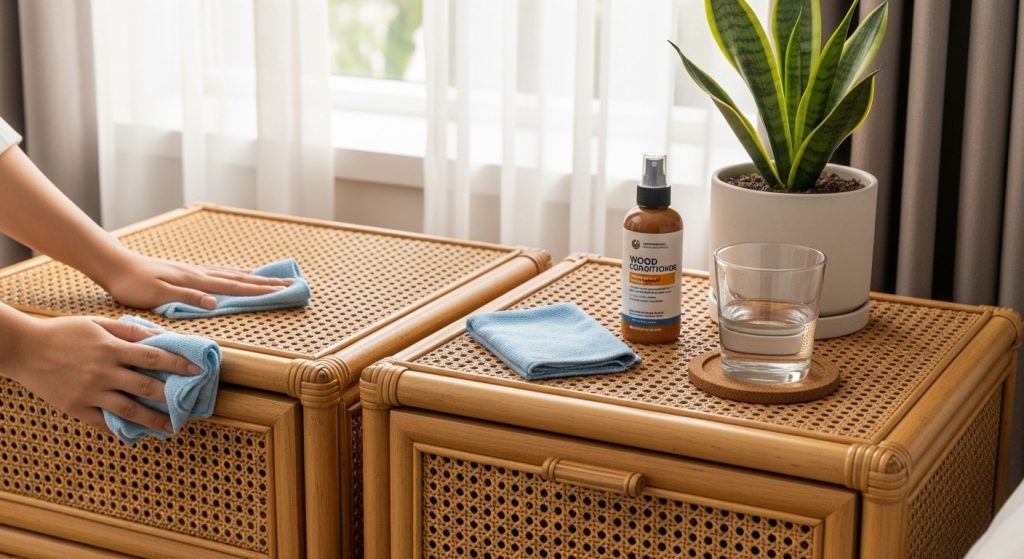Learning how to care for rattan nightstands to prevent fading is essential for preserving the natural beauty and longevity of these popular furniture pieces. Rattan nightstands bring a unique warmth, texture, and relaxed charm to bedrooms, perfectly complementing styles from Boho to Coastal. However, as a natural material, rattan requires specific care to protect it from environmental factors like sunlight, which can cause significant fading and degradation over time.

This definitive guide provides expert insights and professional, step-by-step techniques. It details the best practices for cleaning, maintenance, and protection. This ensures your rattan nightstand remains a beautiful and vibrant part of your sanctuary for years to come.
What is the Core Principle of Caring for Rattan Nightstands?
The core principle of caring for rattan nightstands is gentle consistency. This involves regular, light cleaning to prevent dust buildup, immediate attention to spills, maintaining a stable environment regarding humidity, and, crucially, protecting the natural fibers from the damaging effects of direct sunlight. Rattan is durable but requires mindful care, not aggressive scrubbing or harsh chemicals.
This approach recognizes that rattan is an organic material derived from a climbing palm. Like any natural wood product, it is susceptible to environmental influences. A consistent, gentle maintenance routine respects the material’s nature. It prevents the common issues that can detract from its beauty, such as fading, brittleness, or staining. By treating rattan with care, you preserve its intricate texture and warm aesthetic, ensuring it remains a valuable part of your decor.
Why is Rattan a Natural Material Requiring Care?
Rattan requires care because it is a natural plant fiber. Unlike synthetic materials, its structure and color are susceptible to changes caused by environmental factors. Its porous nature means it can absorb moisture or dry out. Its organic composition means it can be broken down by prolonged exposure to ultraviolet (UV) light. Understanding that rattan is essentially a type of wood vine helps to appreciate why it needs protection similar to other natural furniture pieces.
What Are the Main Threats to Rattan Furniture?
The main threats to the longevity and appearance of rattan furniture include:
- Dust and Dirt: Accumulates within the weave, dulling the finish and potentially causing abrasion.
- Spills and Stains: Liquids can be absorbed into the porous fibers if not cleaned quickly, leading to discoloration.
- Humidity Extremes: Very low humidity can cause rattan to dry out, become brittle, and crack. Very high humidity can cause it to swell and potentially develop mold or mildew.
- Sunlight (UV Radiation): Direct sunlight is the primary cause of fading and long-term structural degradation.
How Does Sunlight Cause Fading and Damage?
Sunlight, specifically its ultraviolet (UV) radiation component, is the most significant environmental threat that causes fading and long-term damage to rattan furniture. This natural process affects all organic materials, breaking down their cellular structure and altering their color over time. Understanding this mechanism is key to implementing effective preventative measures.
What is UV Degradation and How Does it Affect Rattan?
UV degradation is a photochemical process where high-energy UV rays break down the chemical bonds within a material. In rattan and wood, UV light primarily degrades lignin, a complex polymer that binds the cellulose fibers together and gives the material its rigidity and color. As lignin breaks down, the rattan fibers lose strength, become brittle, and undergo a noticeable color change – typically fading to a lighter, yellowish, or grayish tone.
This process is irreversible. Once the color has faded due to UV exposure, it cannot be restored without refinishing or painting the piece. The rate of fading depends on the intensity and duration of the sun exposure. Furniture placed in a south-facing window will fade much faster than a piece in a dimly lit corner. The impact of UV radiation on materials is a well-studied phenomenon.
Are Some Rattan Finishes More Prone to Fading?
Yes, some rattan finishes are more prone to fading than others. Natural, unstained rattan is particularly susceptible, as its inherent color comes directly from the organic lignin compounds. Stained or painted rattan may fade differently. Darker stains often absorb more UV radiation, which can accelerate the breakdown of both the stain and the underlying rattan. Painted finishes may offer slightly more UV protection initially, but the paint itself can fade, chalk, or peel over time with prolonged sun exposure. High-quality finishes often incorporate UV inhibitors, but even these cannot provide complete protection against constant, direct sun.
What Are the Long-Term Effects Beyond Fading?
Beyond the visible fading, prolonged UV exposure causes significant structural damage to rattan fibers. As the lignin breaks down, the fibers lose their natural flexibility and strength. The rattan becomes increasingly brittle and dry. This makes it much more susceptible to cracking, splitting, or breaking, even under normal use. A piece of rattan furniture that has suffered extensive sun damage may become structurally unsound over time. This degradation significantly shortens the lifespan of the furniture.
How to Prevent Fading: The Role of Placement
The most effective strategy for how to care for rattan nightstands to prevent fading is careful placement within the room. Minimizing direct exposure to sunlight is the single most important preventative measure you can take. This requires conscious planning when arranging your bedroom furniture.
Why is Positioning Away from Direct Sunlight Crucial?
Positioning the nightstand away from windows that receive direct, intense sunlight is crucial. UV rays are strongest during the middle hours of the day. South-facing and west-facing windows typically receive the most direct sun. Placing your rattan nightstand against an interior wall or in a corner that does not receive direct sun exposure will dramatically slow down the fading process. While indirect daylight is generally fine, direct beams of sunlight hitting the furniture for hours each day should be avoided at all costs.
How Can Window Treatments Help Protect Rattan?
Window treatments are your second line of defense against UV damage. They can filter or block the incoming sunlight, protecting not just your rattan nightstand but all your furniture, flooring, and artwork. Effective options include:
- Curtains: Heavy drapes or curtains, especially those with a blackout lining, provide excellent protection when closed.
- Blinds: Wooden, faux wood, or fabric blinds allow you to control the amount and angle of light entering the room.
- Shades: Cellular shades or roller shades, particularly those made with UV-blocking fabrics, are very effective.
- UV-Protective Window Film: Applying a clear UV-protective film directly to the window glass can block up to 99% of harmful UV rays without significantly reducing visible light. This is an excellent option for rooms where you want to maintain a bright view while protecting your furnishings. The effectiveness of UV window films is well-documented.
Should You Rotate the Nightstand Periodically?
If some sun exposure is unavoidable, rotating the nightstand periodically (e.g., every few months) can help to ensure that any fading occurs more evenly. This prevents one side from becoming significantly lighter than the others. While this doesn’t stop the fading process, it can make it less noticeable over time. This is a practical compromise for situations where ideal placement is not possible.
What is the Correct Routine Cleaning Process?
Routine cleaning is essential for maintaining the appearance and integrity of your rattan nightstand. Dust and dirt can accumulate within the intricate weave, dulling the finish and potentially causing abrasion over time. A simple, consistent cleaning schedule is key.
How Often Should Rattan Nightstands Be Dusted?
Rattan nightstands should be dusted at least once a week as part of your regular cleaning routine. In particularly dusty environments, more frequent dusting may be necessary. Consistent dusting prevents the buildup of grime that can become harder to remove later.
What Are the Best Tools for Dusting Rattan?
The best tools for dusting rattan are those that can reach into the crevices of the weave without being abrasive.
- Soft Cloth: A dry, soft microfiber cloth is ideal for wiping down flat surfaces and broader woven areas.
- Feather Duster: Useful for a quick, light dusting of the entire piece.
- Vacuum Cleaner with Brush Attachment: This is the most effective tool for removing dust trapped deep within the weave. Use a soft brush attachment and gentle suction.
Why is Vacuuming the Weave Important?
Vacuuming the weave is important because dust particles can become lodged in the tiny gaps between the rattan strands. Over time, this trapped dust can make the furniture look dull and dirty. It can also act as an abrasive, contributing to wear on the fibers. Regular vacuuming with a brush attachment lifts this trapped dust out, keeping the weave clean and preserving its appearance.
How to Handle Spills and Stains Safely?
Accidents happen, and spills on a nightstand are common. Knowing how to care for rattan nightstands when spills occur is crucial for preventing permanent stains or damage. The key is prompt, gentle action.
What is the First Step When a Spill Occurs?
The very first step is to blot the spill immediately with a clean, absorbent cloth or paper towel. Do not rub. Rubbing can push the liquid deeper into the rattan fibers and potentially spread the stain. Gentle blotting will absorb as much of the liquid as possible from the surface. Prompt action is critical, as rattan is porous and can absorb liquids quickly.
How to Clean Sticky Residues or Minor Stains?
For sticky residues (like from a spilled drink) or minor stains, use a slightly damp cloth with a very mild soap solution. Use a gentle detergent, like dish soap, heavily diluted in water. Wring the cloth out well – it should be damp, not wet. Gently wipe the affected area. Follow up immediately by wiping with a clean cloth dampened only with water to remove any soap residue.
What Cleaning Products Should Be Avoided?
Avoid using harsh chemicals, abrasive cleaners, solvents, or furniture polish on rattan. These products can damage the natural fibers, strip the protective sealant, or cause discoloration. Never saturate the rattan with water or use a steam cleaner, as excessive moisture can weaken the fibers and lead to mold growth. Gentle, minimal intervention is always the best approach.
How to Dry Rattan Properly After Cleaning?
Proper drying is essential after any cleaning involving moisture. Gently blot the area dry with a clean, soft cloth. Then, allow the nightstand to air dry completely in a well-ventilated area. You can use a hairdryer on a cool setting (never hot) to speed up the drying process, holding it several inches away from the surface. Ensure the rattan is totally dry before placing any items back on it. Trapped moisture is a primary enemy of rattan.
What is the Importance of Managing Humidity Levels?
Managing the humidity levels in your bedroom is an important, though often overlooked, aspect of caring for natural furniture like rattan. Rattan fibers respond to changes in atmospheric moisture. Extreme dryness or excessive humidity can cause physical damage over time.
How Does Low Humidity Affect Rattan?
Very low humidity, common in heated homes during winter, can cause rattan to lose its natural moisture content. The fibers become dry and brittle. This makes them much more susceptible to cracking, splitting, or breaking under stress. Maintaining adequate humidity helps keep the fibers pliable and strong.
How Does High Humidity Affect Rattan?
Excessively high humidity, common in damp climates or poorly ventilated rooms, can cause rattan to absorb moisture from the air. This can lead to swelling of the fibers. Prolonged exposure to high humidity creates an environment where mold and mildew can grow on the surface and within the weave. Mold growth not only looks unsightly but can also weaken the rattan fibers. The health implications of indoor mold growth are also a serious concern.
What Are Ideal Humidity Levels for Natural Furniture?
The ideal indoor humidity level for preserving natural furniture, including rattan and wood, is generally considered to be between 40% and 60%. Maintaining humidity within this range helps to keep the natural fibers stable, preventing excessive drying or swelling. Using a simple hygrometer can help you monitor the humidity levels in your bedroom.
How Can You Control Humidity in the Bedroom?
You can control humidity using simple devices.
- Humidifier: In dry conditions (winter heating), use a humidifier to add moisture to the air.
- Dehumidifier: In damp conditions, use a dehumidifier to remove excess moisture. Ensuring good air circulation by opening windows periodically (weather permitting) or using a fan can also help to moderate humidity levels.
Can Protective Finishes Help Prevent Fading?
Protective finishes applied by the manufacturer or added later can offer some degree of protection against fading and wear. However, no finish can provide complete immunity from the effects of strong, direct sunlight over the long term. Understanding the role of these finishes is part of a comprehensive care strategy.
What Types of Sealants Are Used on Rattan?
Most commercially produced rattan furniture comes with a protective sealant already applied. This is typically a clear lacquer or varnish. This sealant provides a barrier against moisture, spills, and everyday wear. It also often contains some UV inhibitors that offer a degree of protection against fading. A good sealant is crucial for the durability of the furniture.
Are There Specific UV Protectant Sprays for Furniture?
Yes, there are aftermarket UV protectant sprays available that are designed for use on various materials, including natural fibers like rattan. These sprays add an extra layer of UV filtering compounds to the surface. While they can help to slow down the fading process, their effectiveness varies, and they need to be reapplied periodically (e.g., annually) according to the product instructions. They are best considered a supplemental measure, not a replacement for proper placement away from direct sun. The market for protective coatings is large and diverse.
How Often Should Protective Finishes Be Reapplied?
If your rattan nightstand seems to be losing its original sheen or if the finish appears worn, reapplying a clear sealant can help restore its protection. Follow the manufacturer’s recommendations if available. Otherwise, a light application of a clear, non-yellowing spray lacquer designed for furniture, applied perhaps every few years, can help maintain the protective layer. Always test in an inconspicuous area first.
Conclusion
Learning how to care for rattan nightstands to prevent fading is a straightforward process rooted in gentle consistency and environmental awareness. By protecting your rattan nightstand from the harsh effects of direct sunlight, maintaining a regular cleaning routine, managing humidity levels, and handling spills promptly, you can preserve its natural beauty for many years. These simple, proactive steps ensure that your piece remains a cherished element of your boho bedroom decor or tropical bedroom style, bringing warmth, texture, and timeless charm to your personal sanctuary.











